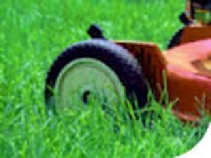Cultural Practices for a Healthy Lawn...& Utimately 50% less pesticides
Most people don't realize how much proper mowing contributes to the overall health and appearance of their lawn. Therefore, let's take a look at some of the mowing basics that will provide you the best possible results: & be on your way to 50% less pesticides.
1ST RULE!!! 80% OF LAWN CARE IS MOWING HEIGHT!!!!!!!!!!
"Mow Your lawn in the coolest part of the day for the cleanest cut." Use a mulching mower and always leave the clippings. "The longer the grass, the deeper the root." Grass growing in the shade needs to be cut as long as possible, since it needs more leaf area to intercept limited light. "Never remove more than 1/3 of the height of the grass at a time." Try to mow often enough. When winter approaches ensure your grass is cut short enough (but not scalped) to prevent it from "laying over" under deep snow cover. Using a 2 to 2-

The most frequently asked questions are:
When is the best time of day to water?-
Lawns that receive little to no water from irrigation or rainfall during summer months will go dormant. Most lawns will recover when water returns. During a severe drought, the grass may die and require over seeding in the fall. This may be acceptable to those looking to conserve water during summer months. Tips for better watering... Deep and infrequent watering maintains a healthy root system and reduces weed infestation (as opposed to light and frequent irrigation, which promotes shallow roots and germination of weed seeds). Applying one inch of water is often difficult to achieve in a single watering given the slow infiltration rate on most soils. Therefore, smaller amounts of water applied every 3 to 4 days may be required to allow water to enter the soil without causing runoff. Water is best applied early in the day (5 to 8 am.) when evaporation loss is lowest. Mow your grass at the right height (3+ inches)during the summer. Longer grass blades increase the depth of the root system, shade the soil, and help drought tolerance. Follow the above practices and we can use at least 50% less pesticides using our lawn care service!